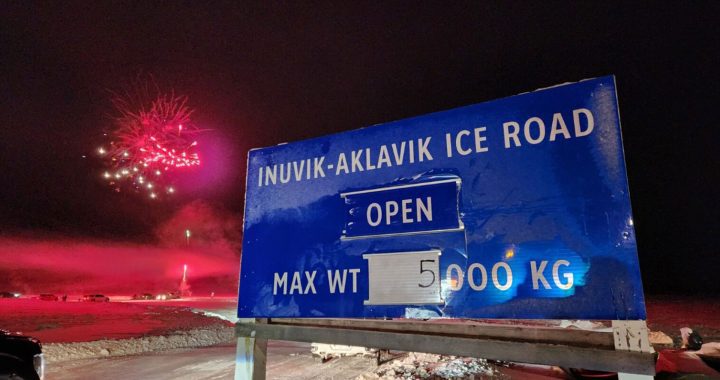Delaney Windigo
Kenneth Jackson
APTN National News
LONDON, Ont. – With a convocation of eagles soaring high above the Thames River in Oneida territory Anthony Nicholas’ sharp eye spots something buried in the ground.
The orange tip is just barely visible in deep silt left behind on the floodplains of the river that receded weeks ago.
“I bet you if we dig down it’s the entire needle,” said Nicholas.
He couldn’t be more right.
Pulling the silty-sand away with a stick exposes a used hypodermic needle syringe about six inches in the ground. The sharp end of the needle pointing nearly straight up protected by its orange cap.
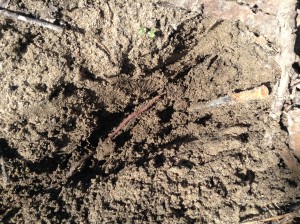
It’s just one of several needles found that day, but Nicholas and fellow resident Darryl Chrisjohn have been finding them all over the floodplains, as well as empty saline packages, tourniquets and condoms.
But it’s the needles that have them the most concerned – first found when a fisherman came across one weeks ago.
“We’ve been finding syringes without the caps and with the caps,” said Nicholas.
A quick look around the area shows there isn’t house in sight, and the shores are a few hundred metres from a gravel road.
“Nobody is coming here to shoot up,” said Chrisjohn who looks up the waterway that leads to the London.
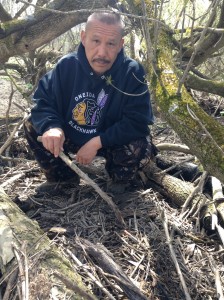
Both are convinced the needles are coming from the city during the spring thaw when the raging river can easily rise more than 10 metres.
They fear the entire flood plains has become a medical waste dump.
Both men have warned people to stay away from the spot used mainly by fishermen and their kids.
“It’s really changed the lifestyle here. I’m not sure what the future is going to hold if we can’t be safe down here with our kids and ourselves as to be aware of needles being found like this one here and who else knows what’s in this junk pile that’s coming down from the city,” said Nicholas.
A quick look at a map shows London is about 30 kilometres from the Oneida of the Thames territory.
APTN National News traveled to London and it didn’t take long to find discarded needles.
A walk along the Thames in downtown London found about 50 needles in a few hundred metres, including a large stash under the bridge at Carfrae park, as both sides of the river appeared to be popular places for addicts.
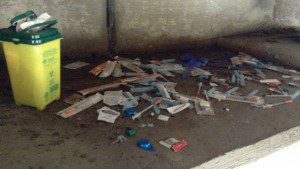
Tom Cull is a local resident and university professor who five years ago started a volunteer group to pick up litter along the river once a month during the spring and summer months.
Cull said he quickly learned they were going to find more than chip bags and old coffee cups.
His group was just out two weeks before he took APTN out for a walk along the Thames May 3.
“We stopped counting around 300 needles in one clean up and I would say over the five years we’ve been doing this, we’ve collected thousands of needles,” said Cull. “Put it this way, we’ve never had a clean-up where we don’t collect needles.”
As it turns out, London has one of the highest intravenous drug problems in the country.
There are about 16 needle drop boxes throughout the city – by the river, parks and playgrounds.
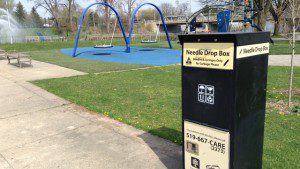
In 2015, London’s needle exchange program distributed 2.7 million needles.
Nearly 800,000 needles are unaccounted for.
They ended up in parks, city streets and the river.
The city said there could be other ways needles may have been returned it doesn’t track such as “public recreation facilities, some social service agencies, restaurants, businesses, landlords and schools.”
It’s a large jump in distribution from 2013 when roughly 1.86 million were handed out and 2.3 million in 2014.
“Unfortunately there’s medical waste throughout the community, along the river I think is because it’s more likely for people to be residing or camping out along the river,” said Sonja Burke, of the Regional HIV/AIDS Connection, which operates the city’s needle exchange program.
Burke said there are times in the year when the needles left behind on the shores of the Thames get washed down river.
“I think it’s important to understand there are two things, one in the spring, the water rises obviously and a lot of the litter including the syringes will get washed down,” she said. “Second of all we do have a high population of individuals who are experiencing homelessness in London right now.”
Burke said while several organizations in the city collect discarded needles there isn’t dedicated funding focused squarely on the recovery of them.
That’s something Cull would like to see happen, who also been campaigning for more needle boxes to be placed throughout the city.
“I would like to see the city as a whole get more serious about litter, get more serious about the environment and get more serious about water quality and the needles is just one piece of that puzzle,” he said.
For now the Regional HIV/AIDS Connection agency plans to introduce a new pilot project by giving out little needle disposal containers in the hopes to get people to properly dispose of the needles.
“We don’t do a one for one, so people don’t have to return the same amount of needles in order to access needles, so encouraging people to dispose of needles appropriately can be difficult at times,” said Shaya Dhinsa, manager of sexual health for Middlesex-London Public Health.
APTN took the concerns of the Oneida residents to London’s public health and a spokesperson questioned how needles could wash so far down the river.
“It’s a good question. I don’t know how you would show that cause and effect,” the spokesperson said.
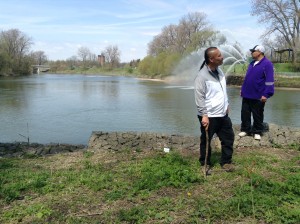
But for Nicholas and Chrisjohn they’re convinced the needles on their territory are coming from London with so many of them ending up in and around the water.
Both traveled to London to walk the Thames themselves. They immediately found needles in Ivey park in downtown by the Forkes, where the Thames begins its route towards Oneida.
“I don’t see it getting any better if this going to keep coming year after year or every time it floods,” said Nicholas.
Chrisjohn doesn’t just want to see the needles stop ending up in the river he wants the land on his territory clean up.
“It needs to be cleaned up ASAP,” he said.
It’s difficult to tell how many needles could be on the Oneida flood plains as much of the land is covered in deep silt.

They’re also concerned with how the needles are affecting the water.
“It’s very concerning and I know it concerns the fishermen and the hunters that are along the river cause we’re mostly the ones that are active down here. You know the water is everyone’s concern. It’s not just our concern,” said Nicholas.




